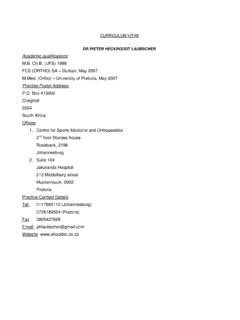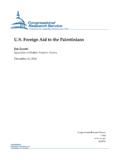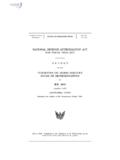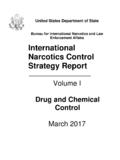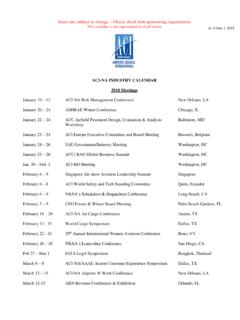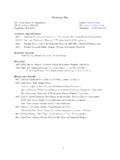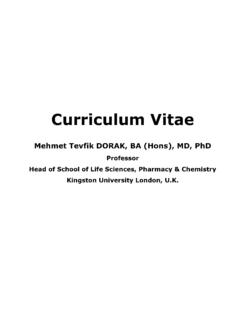Transcription of European guidelines for the certification of …
1 European guidelines for the certification of Haemophilia Centres 07 June 2013. NOTICE. These Standards are designed to provide minimum guidelines for European Haemophilia Centres. These Standards are not intended to establish best practices or include all procedures and practices that Centres or individuals should implement if the standard of practice in the community or governmental laws or regulations establish additional requirements. Each Centre should analyze its practices and procedures to determine whether additional standards apply. 2. Contents Target patient group ..4. Methodology ..5. Delivery of haemophilia care ..5. Standard 1. General General policy and Information about the Centre ..7. Organization and staffing ..7. Policies and Record-keeping and data collection ..8. Personnel appraisal and continuing education.
2 9. Supply and management of therapeutic products, reagents and medical devices ..10. Quality planning, evaluation and Participation in registries related to inherited and acquired bleeding disorders ..11. Participation in clinical 2. Patient Awareness, information and education of patients and their Diagnosis of haemophilia and other related bleeding disorders and all forms of acquired haemophilia ..12. Therapy of haemophilia and other related bleeding disorders and all forms of acquired haemophilia ..12. Treatment programme .. 12. 12. Home treatment plan .. 13. Treatment of acute bleeds and 13. Emergencies, treatment outside normal working hours .. 13. Elective surgery .. 13. Treatment of patients with inhibitors, including immune tolerance .. 14. Treatment of patients with chronic viral 14. Treatment of patients with acquired haemophilia and acquired vWD.
3 14. Periodic clinical and multi-disciplinary review ..14. Genetic Outcome indicators ..16. 3. Advisory service ..16. 4. Network of clinical and specialised services in conjunction with the haemophilia team ..17. References ..19. Authors and Contributors ..19. 3. Introduction This document has been produced by a group commissioned by the European Haemophilia Network (EUHANET) to set standards and criteria for the designation of Haemophilia Centres within Europe, in order to promote standardization of haemophilia and other inherited bleeding disorders care and then to ensure equity of treatment throughout our diverse continent. The document has been drawn up in consultation with both relevant professional organisations such as EAHAD ( European Association for Haemophilia and Allied Disorders) as well as the European Haemophilia Consortium (EHC) and affiliated national patient bodies in Europe.
4 Most of the funding for this project was provided by the European Commission via its Executive Agency for Health and Consumers (EAHC). Background Inherited bleeding disorders are rare but complex conditions to manage. The central philosophy of haemophilia care is that treatment should be delivered by a multidisciplinary team in a dedicated haemophilia centre. There are now data which indicate that outcome is improved when patients are managed in this way. Various health care professionals may need to be involved in the care of an individual patient, including not only a haematologist and nurse but also orthopaedic surgeons, physiotherapists, laboratory technicians, hepatologists and infectious disease specialists, dental surgeons, and psychologists. Advances in recent decades have led to great improvements in both longevity and quality of life of patients.
5 At the same time, it is apparent that there are still great disparities in treatment between individual countries within Europe, in terms of the facilities available for treatment, the types of products used, as well as the amount of factor VIII and IX concentrate used. Target patient group This document refers to the management of patients with inherited bleeding disorders, covering haemophilia A and B (including female carriers), the rarer congenital deficiencies of other coagulation factors (such as fibrinogen and factors II, V, VII, X, XI and XIII), von Willebrand disease and inherited platelet defects. The clinical phenotype of haemophilia is related to the baseline level of the relevant coagulation protein, which may be used to classify the severity. Patients with haemophilia may be classified as severe, moderate or mild.
6 Severe haemophilia is defined by a baseline level of factor VIII (or IX) below 1. iu/dl (%). These patients typically experience repeated and spontaneous bleeding into joints such as the knees, elbows and ankles and require regular treatment. Subjects with a factor VIII (or IX) level between 1 and 5 iu/dl are defined as having moderately severe haemophilia and experience less frequent bleeding. Patients with levels above 5 iu/dl are classified as having mild haemophilia and usually experience bleeding only after injury (albeit minor) or trauma. 4. Methodology A first draft of this document was prepared by the team members of the EUHANET Work package number 4 (WP4: Development of the standardisation criteria) based on a review and analysis of key reference documents including: three EUCERD recommendations on rare diseases1-3, the European Principles of Haemophilia Care4 launched at the European Parliament in January 2009, and information on the existing certification systems in use in European Union Member States.
7 The present document is the result of two consultation processes that widely involved European stakeholders. The first was launched in Prague during the EHC Conference, October 2012 and aimed to share principles and criteria as preliminary requirements to define the scope, approaches and rules for the production of a common set of EU standards on Haemophilia Centres for European countries. The main objective of the first consultation was to get feedback on the principles and criteria proposed by the WP4 Team for the production of Standards for Haemophilia Centres in EU MS. On the basis of the consensus reached and on the literature review, WP4 Team members started the production of Standards. With the agreement of the EUHANET Steering Committee, these standards were subject to a further round of consultation addressed to EU and non-EU MS stakeholders including clinicians, institutions and patients organizations.
8 This second consultation process was launched at the 6th Annual Congress of the European Association for Haemophilia and Allied Disorders held in Warsaw, February 2013. Delivery of haemophilia care All patients with haemophilia and other related bleeding disorders should be registered and treated at designated European Haemophilia Centres. Patients should have access to a comprehensive care programme. This may be provided by a European Haemophilia Comprehensive Care Centre or by a European Haemophilia Treatment Centre which has established a formal relationship with one or more European Haemophilia Comprehensive Care Centres. European Haemophilia Centres European Haemophilia Centres are of two types according to the services and facilities which they provide: European Haemophilia Treatment Centres (EHTCs) provide local routine care in conjunction with EHCCCs.
9 European Haemophilia Comprehensive Care Centres (EHCCCs) provide the highest level of care and function as tertiary referral centres. The functions and activities carried out by the two types of Centres and the agreements between them are described below. 5. European Haemophilia Treatment Centre (EHTC). A EHTC should normally care for at least 10 people with severe haemophilia A or B or VWD type 3. A European Haemophilia Treatment Centre (EHTC) carries out the following functions and activities: Provides care for patients, including diagnosis, treatment, follow-up and rehabilitation. Provides patients with safe and effective treatment products. Provides a 24 hour emergency treatment service. Provides basic diagnostic and monitoring laboratory support during normal working hours for the more common inherited bleeding disorders.
10 Has access to multidisciplinary support, locally or in conjunction with EHCCC (physiotherapy and orthopaedics, surgery, dental care, hepatology, infectious diseases, obstetrics and gynaecology, paediatric facilities if children are treated, genetics, clinical psychology and social worker). Offers specific treatment for patients with inhibitors and immune tolerance in collaboration with a EHCCC. Provides advisory service, including genetic counselling, to patients and healthcare professionals. Promotes information and training programs on inherited bleeding disorders to patients and healthcare professionals. European Haemophilia Comprehensive Care Centre (EHCCC). A EHCCC should normally care for at least 40 people with severe haemophilia. A European Comprehensive Care Haemophilia Centre (EHCCC) carries out the following additional functions and activities: Co-ordinates the delivery of haemophilia services - both in hospital and in the community including liaison with affiliated EHTCs.

